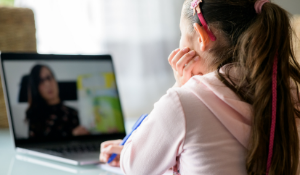
Thousands of students who have been in remote learning since last March have struggled against regression. This is no fault of their own, nor of the educators, who have worked tirelessly to keep up with the almost daily changes to how they’re being required to teach.
Everyone involved has been challenged, and the “learning and teaching from behind a screen” reality has meant a lot of kids check out, retreat, or just disappear. Some are marked absent if they don’t appear on their video screen at prescribed times of day, while others are not required to turn on their video at all. The result is that many students are not having a full-bodied experience of learning. Instead they are becoming simple repositories. And, teachers are not receiving critical expressive feedback since they are staring into blank screens much of the day.
Many students who shied away from interaction in class, those who traditionally sit in the back corner and look to the floor when the teacher is about to call on them, have been able to fall into the shadows even more during remote learning. Even kids who have always been engaged in class may have removed themselves from that level of active involvement in recent months.
You Can Get them Re-engaged
Many students have just returned to in-person learning, with the hope being they can remain in classrooms through the end of the semester. Others are staying remote, so now teachers are having to engage kids on both platforms simultaneously. These ongoing challenges mean teachers need tips and tricks and easy-to-use tools so they can get students motivated, help them reduce anxiety, and make them feel comfortable engaging again.
According to Chelsea Hackett, PhD, adjunct professor at University of Colorado, Boulder and co-creator of vocal-empowerment resource SPEAK, many kids will continue to fall silent if they are not engaged on their levels.
“Students need to be brought out of their comfort zones -- to essentially get comfortable being uncomfortable -- in group settings where it doesn’t feel ‘weird’ to speak out,” said Hackett. “There are ways to get kids back on their cameras, raising their hands and feeling comfortable in their own skin. Using tools that meet them on their level and engage them in ways they understand, like using games, meditations, and exercises or having them submit short videos, can be extremely effective.”
Creative Tools
The onus is on educators to seek and find creative ways to reach students, whether remotely or in classrooms. This can feel daunting, especially given all the changes and challenges teachers have faced head-on the past year. Keeping kids physically and verbally engaged is essential for long-term confidence and self-empowerment.
Some ways to make shifts to increase engagement during distance learning include:
- Incorporating games and mirroring activities
- Implementing group physical expression activities
- Encouraging students to use the chat box, but also offering moments for students to speak all at once, then in small groups, then individually
- Incorporating mental health moments like dancing, meditation, or simply taking a group
water break.
These are all positive ways to increase socialization and self-expression, which students desperately need right now. This integrated approach will give kids the best chance to make up for what many believe is lost time, and go into their next year of academia with excitement, confidence, and energy.

